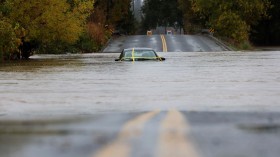At least a few of you out there have been anticipating the fall and the vibrant colors of the leaves finally revealed -- finally relieved of the green chlorophyll they'd been storing for months. The foliage of New England and parts of upstate New York are typical points of interest this time of year, but there's a more remote region that puts them to shame.
Chile's Atacama Desert is notorious for being one of the driest places in the world, but is barely recognizable this autumn after unprecedented rainfalls from El Niño. It has almost psychedelic patterns of color: hot fuchsia and purple surrounding the arid and rocky mountaintops. Many of the flowers give off an almond scent -- and you might think amidst these fields and the herbal grasses that you're walking in a biblical paradise.
This happens every five to seven years, says Pedro León Lobos, a botanist with Chile's Institute of Agriculture and Livestock Research (IRA), according to National Geographic. Some of the flowers in bloom have remained dormant in the ground for several years, just waiting for the right opportunity to blossom. Since parts of the desert receive as little as 0.04 inches of rain a year, the time is hardly always right. In fact, this autumn surprise may not have much more time left, with many flowers expected to die off by late November. So how is it possible for life to exist in this absolute desert? The unprecedented rainfall of 0.96 inches is more than what usually falls over a decade, and left a number of mudslides across the country, resulting in the deaths of 26 people.
There's another valuable asset beneath the Atacama Desert: mummies that date back 9,000 years, making them some of the oldest known in the world. In some areas of this desert, it hasn't rained in four centuries, making it the ideal place to keep them well-preserved -- like the tombs of Egypt. However, it might surprise you that the mummies are an endangered species -- rapidly deteriorating as the climate becomes more humid. It could be that climate change is to blame.
The area around the Atacama is an array of contrasts. For instance, it is right next to the Amazon River Basin, one of the wettest places on Earth. South America is also home to several glaciers, 80% of which are in Chile. As these glaciers retreat, the rivers become wider and more abundant. Combined with a low pressure system altering the flow of air, we may be witnessing the gradual changeover of one of the most unusual places on Earth - as the arid land again becomes fertile. However, it may also mean the end of a fragile ecosystem -- one that has accommodated over 1,900 known species of plants.
For more great nature science stories and general news, please visit our sister site, Headlines and Global News (HNGN).
© 2024 NatureWorldNews.com All rights reserved. Do not reproduce without permission.





